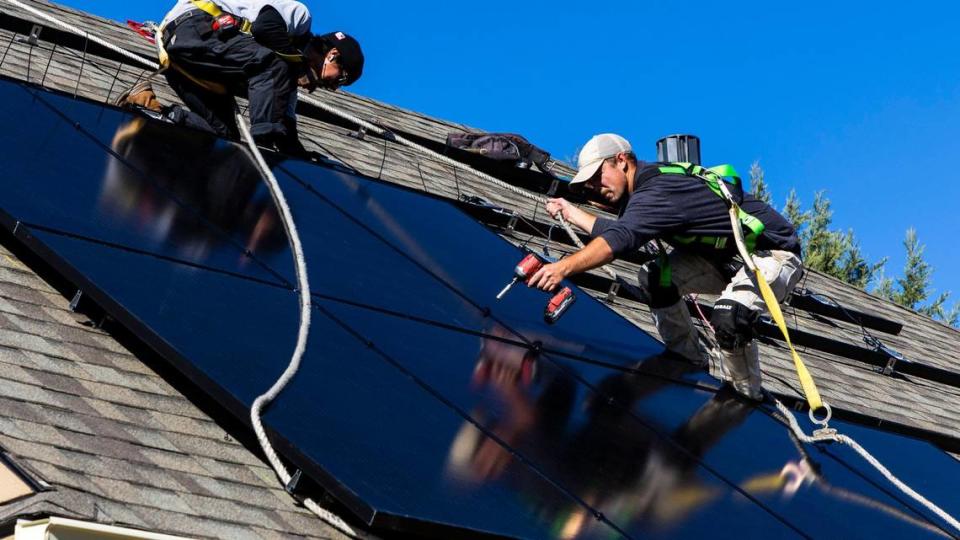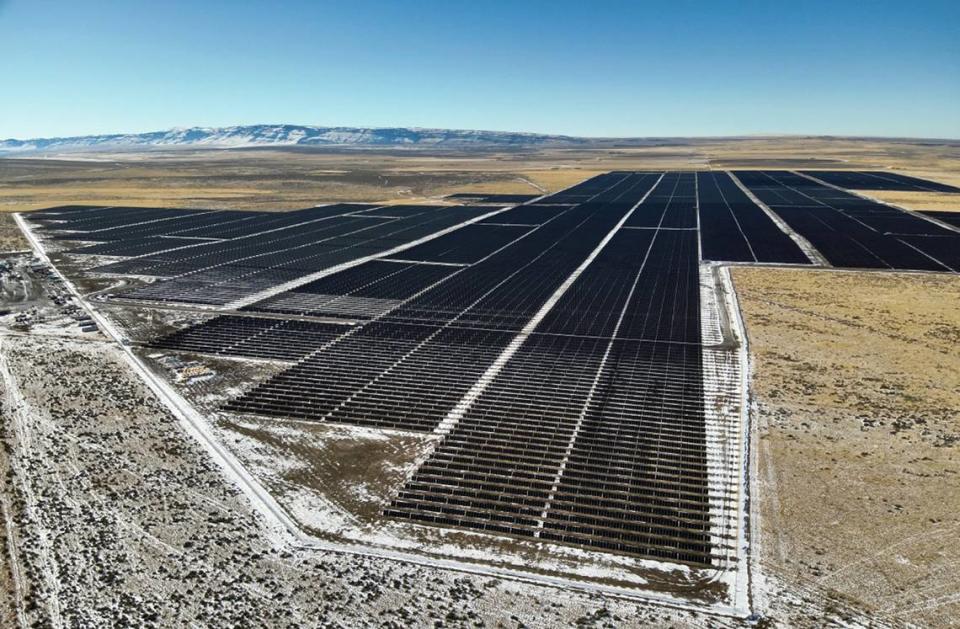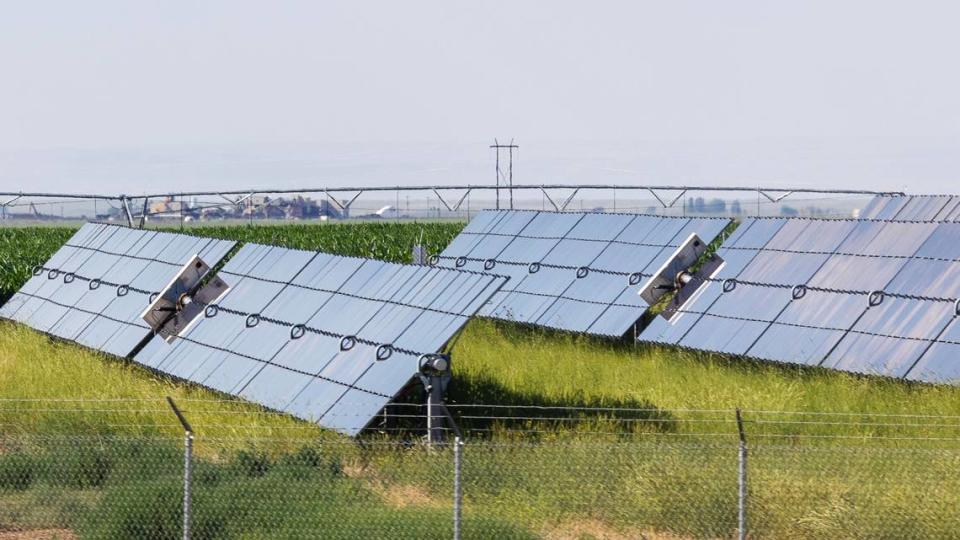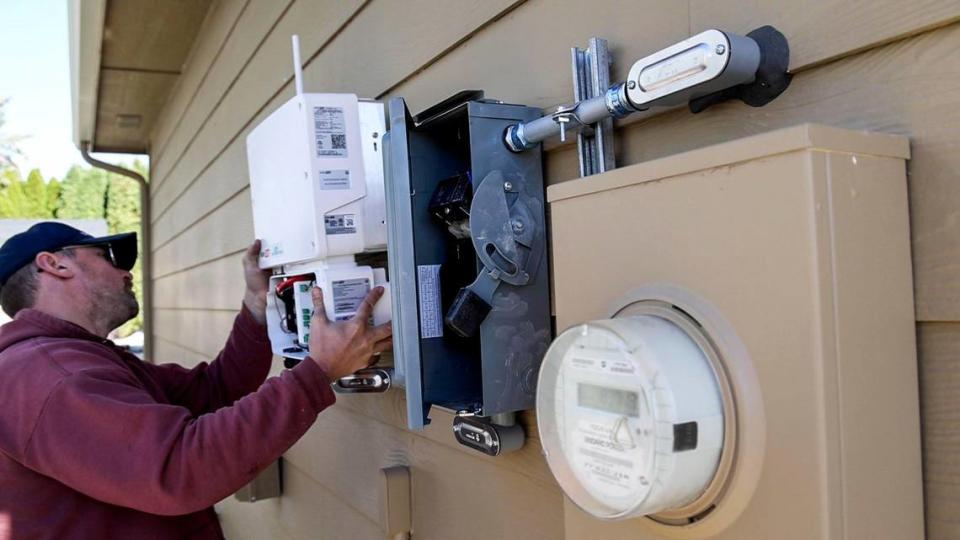Idaho Power to shift solar compensation to on-peak, off-peak times. What it means to you
Idaho Power wants to change a state-level policy that compensates households with rooftop solar panels for the excess energy they generate and send back to the grid.
The policy, called net metering, allows customers to receive credits on their utility bills equivalent to retail electricity rates when they produce more energy than they need. For every kilowatt hour of solar energy sent to the grid, the customer receives a kilowatt-hour credit.
The compensation helps offset the initial costs of installing a solar system, making it a more viable investment.
But the state’s largest electric utility is proposing to lower that compensation and bring about other marked changes that solar advocates say could hurt the burgeoning renewable energy business and reduce the resiliency of local electricity grids.
The fight over net metering has played out across the country, from California to Kansas to Florida, as power companies reckon with the growing shift towards solar.
What’s in the proposal?
In May, Idaho Power filed an application to implement a slew of changes to the compensation structure for customers with on-site generation, which most commonly means rooftop solar but can also apply to windmills, geothermal and small hydro projects.
The two biggest items are an adjustment to the export credit rate and a switch from net monthly billing to real-time net billing, which the company says would better measure customers’ reliance on the grid.
Retail rates for homeowners are now typically between 8 cents to 10 cents per kilowatt hour, depending on how much energy is used. In the filing, Idaho Power looks to shift energy valuation to on-peak and off-peak times, with varying rates for each, but for an average annual rate of nearly 6 cents.
It also proposes updating the rates each year.
On-peak would cover the summer months, from June 15 through September 15, on Monday through Saturday from 3-11 p.m., excluding holidays, at a rate of 20.42 cents. The eight-hour window is when Idaho Power says it experiences its highest demand.
All other hours are defined as off-peak, at a rate of 4.91 cents.

The overall reduction in compensation stems from the rising popularity of solar systems. Idaho Power argues current pricing overcompensates customers with solar at the expense of those without.
About 12,000 customers, or 2% of the company’s roughly 600,000 customer base, participate in on-site generation. The utility sees the number only continuing to grow, and wants to eliminate cost-shifting before it gets much larger, according to Jordan Rodriguez, a spokesperson for Idaho Power.
“We’re trying to achieve a fair and accurate valuation of customers’ exported energy,” Rodriguez told the Idaho Statesman.
If the proposal is approved as-is, the monthly bill for the average residential customer with rooftop solar would go up by about $12, he said. Idaho Power has asked to implement the changes in January.
Better return for panels facing west
The restructuring would benefit west-facing panels “a lot more” than south-facing panels, according to Lisa Young, director of the Idaho Chapter of the Sierra Club, a nationwide environmental organization.
That’s because the proposed export credit rate is more than 3 times higher during the summer in the later part of the day, as the sun sets in the west.
“It’s very clear now that the west side is going to be the best side to install,” Young told the Statesman by phone. “If your system is facing west, you’re going to be able to capture more and export more power during that time of day and get more money for it.”
What’s unclear is how many customers will be able to take advantage of the on-peak rates. The solar energy generated on hot summer nights may be more useful to those producing it, as people make dinner and run their air conditioning and farmers water their crops.
Still, solar companies could begin encouraging customers to install on the west side of their homes. Though that may not always be possible, based on the way a roof is shaped.
Young said she sympathizes with people who’ve affixed solar panels to the south side of their house in the last few years, as solar installers often recommend, not knowing the decision could affect their future payback.
“We’ve always known that the compensation rates are probably going to go down,” Young said. “But I don’t think we knew that not only would the rates maybe go down, there would be this whole new structure where there’s more value during different times of the day.”
‘Big period of change’ for solar
Alex McKinley, co-owner of Empowered Solar in Boise, started his small solar company in 2015. McKinley grew up in Boise and went on to study renewable energy in a master’s program in Europe before returning to Idaho to “try to make a positive change.”
He’s watched the debate over solar regulations ebb and flow over the years.
McKinley told the Statesman by phone that he worries Idaho Power’s proposal could limit the affordability of installing solar panels.
“Moving forward, people want a more reliable, more dynamic and more flexible electricity grid. Residential solar is a part of that,” he said. “We’re in a big period of change, and I think this can be a positive thing if it’s done right. If it’s done poorly, it can really impact all customers, not just those with solar.”
Today, less than 4% of Idaho Power’s energy mix is solar.
More than 30% of the company’s energy comes from hydropower, 10% from wind, 20% from coal and about 12% from natural gas. The utility’s goal is to rely completely on renewable energy sources by 2045.

It has relatively new contract with Jackpot Solar, a 950-acre solar farm south of Twin Falls, to purchase the power it generates for the next 20 years. Jackpot Solar came online in January with a capacity of 120 megawatts, enough energy to power about 24,000 homes. It’s the largest solar farm in Idaho.
Idaho Power also has a 20-year contract with Idaho Solar 1 to buy the 40 megawatts of energy it produces at a solar farm in south Kuna.
While the company has expanded its solar usage in the state, McKinley said the changes its proposing to net metering could discourage customers from investing in solar, making them more reliant on other forms of energy. If customers generate their own power, they don’t need to buy as much from Idaho Power.
“I think there’s a disconnect between Idaho Power’s rhetoric — wanting to have green, clean power by 2045, and how they’ve actually approached it,” McKinley said.
What happens next?
The Idaho Public Utilities Commission has the authority to approve, reject or modify the proposal. The entire process could take several months and will likely involve public hearings.
The commission’s job is to regulate privately owned utilities and ensure the companies provide adequate, safe and reliable service to their customers at just and reasonable rates. The governing body is made up of three governor-appointed commissioners.
About five years ago, Idaho Power proposed a change to the credit-based system that resulted in a settlement that was ultimately rejected by the commission for lack of public involvement. Since then, the utility company and its stakeholders have been incrementally working toward a compromise.
The commission requested Idaho Power produce a study on the value of distributed energy resources such as rooftop solar power.
That study, released a year ago, drew sharp criticism from the solar industry — businesses that sell and install equipment, homeowners with rooftop solar and environmental groups. They argued that it undervalued customer-generated solar and sought to protect the company’s interests in owning and profiting from the renewable energy source.
At a public hearing in November, dozens of Treasure Valley residents testified that they did not want to see the export credit rate go down.
“That credit is applied at the full retail rate, which reflects the full cost of generating, transmitting and delivering reliable electric service to our customers,” Idaho Power’s study said. “However, only a portion of that retail rate represents energy generation. The rest pays for building and maintaining the grid, running a customer care center and other expenses that apply to all customers.”

Various environmental organizations and solar companies commissioned their own report, seeking to provide an independent analysis of Idaho Power’s study. It was produced by Crossborder Energy, a Berkeley, California, consulting company for the energy industry.
The report concluded that excess power from on-site generation is worth 18.3 cents per kilowatt hour, about five times more than Idaho Power’s valuation in its study, which was 2.8 cents to 4 cents per kilowatt hour.
The uncertainty around net metering rates has slowed investments from some of the biggest solar customers, according to Brad Heusinkveld, an energy policy associate with the Idaho Conservation League.
The league filed a petition to intervene in the case, indicating it has a stake in the outcome. Micron, the city of Boise, the Idaho Irrigation Pumpers Association, Vote Solar, IdaHydro and Clean Energy Opportunities for Idaho have also filed to intervene.
“ ... Think commercial generators, rooftop for big box stores and big irrigators. What they want is certainty,” Heusinkveld told the Statesman by phone. “They need to be sure that their investment will pay off. This process has really delayed that, so a lot of people are looking forward to the conclusion of this as much as anything else.”
Some customers’ capacity could increase
One change proposed by Idaho Power in its latest filing could benefit those large customers.
The utility intends to raise an eligibility cap that prevents customers in the commercial, industrial or irrigation category from installing a solar array of more than 100 kilowatts.
Young said the adjustment will allow customers to install solar systems that fit their own needs. She welcomes the change.
“The 100-kilowatt cap is something people have been wanting to get rid of for a long time,” Young told the Statesman. “There’s many farmers out there that would love to put up a 200- or 300-kilowatt system to help run their irrigation pumps.”
Schools and warehouses could also benefit from the modification, she said.
Many systems are grandfathered in
During previous rulings, the PUC granted legacy status to eligible residential and small general-service on-site generation systems as of Dec. 20, 2019. The status was also granted to eligible commercial, industrial and irrigation systems as of Dec. 1, 2020.
That means Idaho Power customers who were already generating solar energy by those dates will get to keep the higher rates for about 25 years, which is the standard lifespan of a solar power system, according to Rodriguez.
Systems connected after those dates are subject to the proposed changes.

Eric Bluemn, a physician living in Boise’s East End, worries the new compensation structure would make it harder to pay off the solar panels he installed on his roof in spring 2021. His system won’t be grandfathered in.
He said he installed the panels because he wanted to invest in something that was environmentally friendly, and he also liked the idea of producing his own power and having some energy independence, as well as the long-term financial benefits of saving on his power bill once the infrastructure is paid off.
“In a place where we get this much sun, if you’ve got an open rooftop ... I thought it was a worthwhile investment,” Bluemn said. “I didn’t expect the goalposts to be moved like this.”
His solar installation — 20 panels — cost about $18,000, and based on the rates when he installed, repayment could take 12-15 years. But with the new changes, it’ll likely be longer. Bluemn said his girlfriend was considering investing in solar panels as well, but decided to pause those plans until there’s more certainty.
He hopes the commission will seriously consider Crossborder Energy’s report.
“If I was trying to prescribe a drug or use a device for a patient, and the only study out there was put forth by the company that stands to benefit from it, and there was no independent third-party review, then I wouldn’t feel good trying to push that drug or use that device on a patient, because there’s obviously a conflict of interest,” he said. “That’s my biggest takeaway from this whole thing, where Idaho Power publishes a study and its rubber-stamped by the utilities commission.”
The commission has not yet scheduled a public hearing on the proposal. Written comments or questions can be submitted through a form on the commission’s website. The case number is IPC-E-23-14.
Disclosure: The Idaho Statesman pays Jordan Rodriguez, a spokesperson for Idaho Power, to write a fishing column for the Statesman.
Idaho Power eyes more solar. But here’s why clean energy remains a challenge
First time in over a decade, Idaho Power seeks base rate hike. See how much it could be
An Idaho cobalt mine stopped production. But now, the military’s interested

